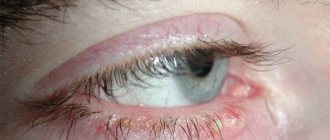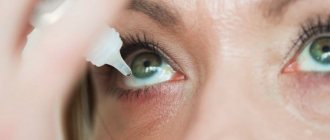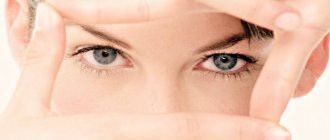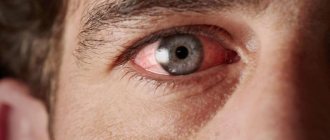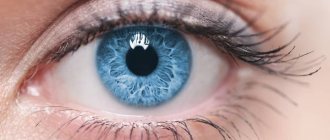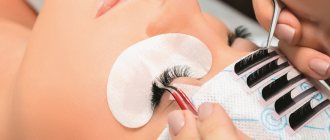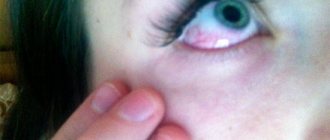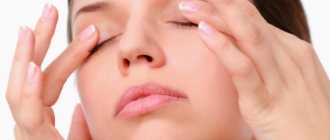Blepharitis is a whole group of diseases associated with inflammatory processes occurring at the edges of the eyelids. In most cases, the pathology has chronic forms, which periodically pass into the acute phase. Treating the disease is quite difficult, and therapy will depend directly on the type of pathology and the reasons for its development. For example, it is quite difficult to overcome demodectic blepharitis, the symptoms and treatment of which we will try to analyze in this article.
Blepharitis - what is it?
blepharitis Source: vseozrenii.ru
Blepharitis is an inflammation of the edges of the eyelids. Typically, blepharitis is a chronic disease that is difficult to treat.
Anatomically distinguished:
• anterior marginal blepharitis – damage only to the ciliary edge of the eyelids. • posterior marginal blepharitis – accompanied by inflammation of the meibomian glands in the thickness of the eyelid, while the conjunctiva and cornea may be involved in the pathological process
In the initial stage, inflammation is quite difficult to diagnose and most often a person sees an ophthalmologist with an advanced form of tick-borne blepharitis. To make an accurate diagnosis, it is necessary to examine the patient’s eyelashes in a medical laboratory.
In fact, in most clinical cases, both anterior and posterior marginal blepharitis are observed simultaneously, that is, the eyelid becomes inflamed throughout its entire thickness.
The disease is quite serious and requires long-term treatment. The clinical symptoms of demodectic blepharitis are especially pronounced in people with weakened immune defenses.
Adjuvant therapy
Treatment of blepharitis is combined with mandatory hygiene procedures, as well as self-massage of the affected area using Blepharogel 2. The same drug is used in phonophoresis procedures aimed at improving the functioning of the meibomian glands. Regular cleaning of the surface allows you to get rid of toxic waste from parasites that can cause allergic reactions.
As an auxiliary therapy, the patient is prescribed drugs to strengthen the immune system, vitamins and mineral complexes. Particular attention should be paid to the cleanliness of the patient's bed linen and towels. They must be boiled or steamed and dried in the sun. Such measures will help avoid re-infection.
For demodectic blepharitis, it is recommended to consult such specialists as:
- dermatologist,
- nutritionist,
- gastroenterologist,
- allergist.
During treatment, you need to limit the consumption of spicy, sour or salty foods, avoid going to the bathhouse or sauna, or visiting the pool.
In case of demodectic blepharitis, you will need to visit, in addition to the ophthalmologist, a dermatologist, nutritionist, gastroenterologist and allergist.
Stages and forms of the disease
types of disease Source: zrenieglaz.ru
This disorder is difficult to treat and the process usually takes at least two months. Completely healthy people can be carriers of the parasite.
Blepharitis can develop due to decreased immunity:
- increased visual fatigue occurs;
- eyelids swell;
- eyes turn red.
There are types:
- infectious;
- scaly;
- allergic.
It can appear at any age, but according to statistics, it most often occurs in older people. In children, the described type of disease may be associated with helminthic infestations.
Most often, inflammation occurs in the ciliary area of the eyelids. During the illness, relapses occur and the person may lose his vision.
Based on the results of studies by scientists of people who previously suffered from demodectic blepharitis, we can say that a similar disease is more often observed in men.
Women regularly use eye cosmetics, which in turn somewhat reduces the risk of developing the disease. And it’s more about hygiene, because women use special products to remove makeup, periodically treating the affected areas with mites.
This disease is classified according to several criteria, but most often it becomes a chronic condition with a risk of relapse.
The chronic form of demodectic blepharitis has a particularly long and complex treatment.
Diagnosis of demodectic blepharitis
Patients will not be able to diagnose themselves due to the fact that the first symptoms of the disease are similar to those of other eye pathologies. Swelling of the eyelids and itching are most often attributed to allergies to something in everyday life, eye fatigue, or conjunctivitis. Few people even think about the presence of Demodex mites. And only a doctor will be wary when examining a patient, seeing certain signals indicating mite activity. Unfortunately, many people turn to an ophthalmologist when the disease develops into a chronic form.
To identify a tick, it is important to undergo a thorough examination, although the doctor will detect blepharitis even during a visual examination. An experienced ophthalmologist will only need to assess the condition of the eyelashes, the presence of plaque around them, and see the inflamed edges of the eyelids.
On a note! Patients with demodicosis are also often diagnosed with psoriasis, styes, and chronic acne.
A laboratory examination is carried out as follows: the doctor will take 4 eyelashes from each eyelid from the patient, prepare a so-called laboratory preparation from them using glycerin and carefully examine it under a microscope. Before the study, the patient is prohibited from washing his face, much less using cosmetics. If demodectic blepharitis is present, the doctor will find mites on the eyelashes. The patient may also be referred for examination of tear fluid and assessment of the correct functioning of the meibomian glands.
Causes of tick-borne blepharitis
causes of the disease Source: poglazam.ru
The method of infection with Demodex is through contact and household contact. Signs of blepharitis mainly appear due to a weakened immune system.
Factors influencing the occurrence of demodectic blepharitis:
- prolonged exposure to high temperatures;
- sunburn;
- failure to comply with sanitary standards at home or at work;
- ophthalmological operations;
- diseases of the nervous, vascular or endocrine system;
- diseases of the digestive tract and liver.
Tick-borne blepharitis in younger patients is associated with helminthiasis (infection with worms) and pediculosis.
In most cases, after infection of the eyelids, the Demodex mite spreads to the skin of the face.
Therefore, there is a risk of the following diseases:
- chronic inflammation of the conjunctiva.
- inflammatory lesions of the conjunctiva and cornea.
- lipid-deficient form of xerophthalmia (dry eye syndrome).
To avoid complications, timely treatment is necessary.
Diagnosis and treatment
To establish a diagnosis, an examination of the eyelid using a slit lamp is performed. To determine the cause of the disease, a scraping is taken from the roots of the eyelashes and conjunctiva. For blepharitis of an allergic nature, allergy tests are prescribed to determine the allergen.
Treatment involves the rehabilitation of chronic foci of infections, the creation of favorable hygienic working conditions, proper nutrition, elimination of allergies, correction of refraction, as well as measures to increase the body's resistance.
For more information about the treatment of blepharitis, call Dr. Kurenkov's ophthalmological center at +7 (495) 781-9333.
General symptoms and features of individual clinical forms of blepharitis
symptoms Source: Okulist.pro
Demodectic blepharitis is a very serious disease. And this is why it is very important to recognize it in the early stages. Symptoms will help with this.
The main signs of tick-borne blepharitis:
- the edges of the eyelids turn red, thicken, and become heavy;
- itching, peeling, burning at the base of the eyelashes;
- the mucous membrane dries out, a feeling of sand appears in the eyes;
- excessive secretion of tear fluid;
- dry crusts at the base of the eyelashes, the skin under them bleeds;
- eyelashes are brittle and fall out;
- eyes get tired quickly;
- Discharge accumulates in the inner corners;
- white growths near the eyelashes.
The following clinical forms are distinguished:
• Scaly, or seborrheic, blepharitis is often combined with seborrheic dermatitis of the scalp, eyebrows, and behind-the-ear areas, characterized by redness and thickening of the edges of the eyelids with the formation of scales between the eyelashes, tightly attached to the skin.
When the scales are removed, the skin remains intact and does not bleed. You can see yellowish crusts along the edges of the eyelids - this is dried sebaceous gland secretion. Over time, the swelling of the edges of the eyelids increases, the eyelids no longer adhere to the eyeball, and lacrimation appears. Sometimes the process spreads to the conjunctiva and blepharoconjunctivitis develops.
With a long course of scaly blepharitis, partial alopecia (loss of eyelashes) occurs, and eyelid inversion may form.
• Ulcerative blepharitis is characterized by purulent inflammation of the hair follicles of the eyelashes, purulent crusts are formed, when removed, bleeding ulcers with purulent plaque are formed, subsequently scars form in their place.
Since the hair follicles are involved in the process, the eyelashes fall out. In some cases, madarosis may develop - a complete absence of eyelashes.
Scar changes can lead to abnormal growth of eyelashes and deformation of the eyelids - eversion or entropion.
• Demodectic blepharitis occurs when the eyelids are infected by the Demodex mite.
At first, patients are bothered by severe itching, especially after sleep, a sticky discharge appears, then severe inflammation of the ciliary edges of the eyelids develops, which become thickened and reddened. The secretion of the sebaceous glands and particles of cells form a “collar” or “muff” at the base of the eyelashes.
The dried discharge accumulates in the form of scales between the eyelashes. Mites are found at the root of removed eyelashes during microscopic examination.
• Allergic blepharitis is usually combined with allergic inflammation of the conjunctiva.
The reason is hypersensitivity to any substance: medications, cosmetics, dust, wool, feathers, fluff, etc. Allergic blepharitis can be either acute or chronic.
The patient is concerned about: swelling of the eyelids, itching, lacrimation, mucous discharge, pain in the eyes. Usually both eyes are affected.
Treatment with folk remedies
Blepharitis is very often protracted, has periods of remissions and exacerbations, so the results of drug treatment are not always satisfactory for patients. In such cases, some resort to traditional methods of treatment, which, by the way, also give very good results.
Here are a few recipes for treating blepharitis at home using traditional recipes:
- Thyme infusion. 1 tablespoon of dried thyme (available freely in most pharmacies in tea bags) is poured into 200 ml of boiling water and allowed to brew for 15 minutes. Wash your eyes with this solution 3 times a day for two weeks;
- Burdock oil is well suited for the treatment of seborrheic blepharitis. It is applied to the edges of the eyelids twice a day. This product softens scales, and extractive substances reduce peeling and enhance tissue regeneration;
- An infusion of celandine herb helps quite well in the treatment of ulcerative blepharitis. The infusion is prepared as follows: 1 tablespoon of dried celandine herb (also sold in filter bags in pharmacies) is brewed in a glass of boiling water and allowed to brew for 30 minutes. Moisten a cotton swab with the infusion and apply it to the eyelid area for 3-5 minutes. The course of treatment lasts no more than two weeks.
Diagnostics
As a rule, patients complain of a burning sensation, itching in the eyelid area, aggravated by heat, redness of the eyelids, a feeling of “heaviness” of the eyelids, a feeling of discomfort and “dryness” of the eyes.
Biomicroscopy: the edges of the eyelids are thickened and hyperemic. A characteristic sign of blepharitis of demodectic etiology is the presence of “white muffs” or “collars” at the base of the eyelashes on glued eyelashes.
Subsequently, severe inflammation of the ciliary edges of the eyelids develops, which become thickened and reddened.
With a long-term chronic course, the edges of the eyelids become deformed, smoothing of the anterior and posterior ribs of the free edge of the eyelids occurs, which can result in trichiasis.
Laboratory examination of eyelashes using Demodex. The material for studying mites is epilated eyelashes, 3-4 from each eyelid, which are placed on a glass slide in a drop of glycerin, covered with a coverslip and microscoped.
The diagnosis of demodicosis is made based on the detection of any phases of mite development during a microscopic examination of epilated eyelashes.
Tests for tear production and meibomian gland dysfunction. In order to diagnose dry eye syndrome and to decide on the advisability of prescribing tear replacement therapy, a Schirmer test is performed, a decrease in the indicators of which indicates a violation of the secretion of the aqueous phase of the tear film, as well as a compression test and a test for VRSP.
Changes in the performance of these tests are a consequence of MGD and an indication for tear replacement therapy.
Treatment of Blepharitis
Modern medicine provides a large number of treatment options. The main factor for a successful outcome is patience, both of the doctor and the patient.
After all, demodectic blepharitis is a serious disease, and it is advisable to start treating it in the early stages.
To speed up recovery you need to:
- observe the rules of personal hygiene;
- massage the eyelids;
- introduce protein foods into your diet;
- To strengthen the immune system, take vitamins.
Scientists have made great progress in developing treatments for blepharitis. Effective drugs have been created and methods of physiotherapy have been developed.
Nevertheless, treatment for blepharitis is difficult and lengthy. It requires patience and persistence from both the doctor and the patient.
It is important to identify and eliminate the cause of the disease. Otherwise, it will recur and progress, despite the treatment.
And the patient, if he wants to recover quickly, must scrupulously follow the doctor’s orders.
Ulcerative blepharitis
Careful eyelid hygiene is necessary. Crusts and discharge are removed with a damp cotton swab.
If the crusts are rough, they are first softened with a damp lotion or by lubricating the edges of the eyelids with ointment. A complex ointment containing a corticosteroid and an antibiotic is applied to the edges of the eyelids with a finger or a glass rod: dexa-gentamicin (dexamethasone 0.1% + gentamicin 0.3%), and in case of intolerance to gentamicin - complex ointment Maxitrol (dexamethasone 1 mg/g, neomycin 3.5 mg/g, polymyxin B 6 thousand units/g).
In cases of conjunctivitis or marginal keratitis, additional eye drops of dex-gentamicin or maxitrol are instilled.
For corneal epitheliopathy or corneal ulceration - solcoseryl eye gel, Vitasik eye drops (containing adenosine, thymidine, cytidine, uridine, guanosine, etc.) or corneregel (dexpantheol 50 mg/g).
Seborrheic blepharitis
Eyelid hygiene plays an important role. For therapeutic purposes, the following is prescribed: lubricating the edges of the eyelids with hydrocortisone eye ointment (hydrocortisone-POS - 1%, and in severe cases - 2.5%), instillation of “artificial tears” eye drops: natural tears or oftagel.
For symptoms of conjunctivitis, dexamethasone eye drops 0.1% (Dexapos or Maxidex) are prescribed.
Blepharitis demodectic
The main goal of treatment is to reduce the level of mite infestation.
Hygienic care of the eyelids is recommended: wipe the eyelids twice a day with a swab soaked in saline solution, diluted baby shampoo or a solution of 70% ethyl alcohol with ether.
The edges of the eyelids are lubricated with hydrocortisone-POS 2.5% ophthalmic ointment and dex-gentamicin ophthalmic ointment. It is important that before going to bed the edges of the eyelids are generously covered with ointment, this disrupts the life cycle of mites.
For symptoms of conjunctivitis, instillation of Dexapos eye drops is prescribed 1-2 times a day. It is advisable to massage the eyelids followed by treatment of the edges of the eyelids.
Allergic blepharitis
Eliminating the “culprit” allergen, if possible, is the most effective and safest treatment method. Treatment includes long-term combined use of antiallergic eye drops (lecrolin, alomide) and lubrication of the eyelid edges with anti-inflammatory corticosteroid eye ointment (hydrocortisone-POS).
For infectious-allergic blepharitis, the edges of the eyelids are lubricated with Dex-gentamicin or Maxitrol eye ointment. To prevent the progression of blepharitis, you should never self-medicate.
But how often, when pain, swelling of the eyelids and other symptoms of trouble appear, patients buy over-the-counter albucid at the pharmacy and begin to “be treated.” It is unacceptable!
You should consult a doctor promptly to have your vision checked, especially after 40 years of age. At this age, due to a decrease in the refractive power of the lens, difficulties arise when working at close range, and the eyes quickly tire.
And against this background, as already mentioned, an inflammatory disease of the ciliary edges of the eyelids often develops.
Those who have allergic blepharitis should protect their eyes from dust, wear sunglasses, not use mascara or eye shadow, and try not to travel outside the city during the flowering period.
It goes without saying that those who have blepharitis as one of the symptoms of diabetes or a disease of the digestive system must first treat this disease and strictly follow the diet prescribed by the doctor.
For other forms of blepharitis, no special dietary recommendations are required, with the exception of one thing: the diet should contain as many vitamin-rich foods as possible.
Eyelid care for blepharitis
Regardless of the cause that led to the development of blepharitis, it is very important to follow a dairy-vegetable diet during an exacerbation.
Meat can only be eaten boiled. Nothing fried, salty, pickled or sweet is allowed.
All this will increase the secretion of gastric juice, which - imagine! - will immediately affect the condition of the eyelids.
Have your stool tested to rule out helminthic infestation.
Constantly monitor the condition of the gastrointestinal tract. For constipation, take laxatives. Protect yourself from so-called colds: blepharitis will worsen.
Therefore, during epidemics of influenza and ARVI, take appropriate measures.
Start every morning with hygiene procedures.
Remember that eyelids affected by blepharitis cannot tolerate cold water. You can continue hardening (either a cold shower or an ice-hole), but rinse your eyelids only with warm water.
Cold will cause venous stagnation and aggravate the course of the disease, warm will cause arterial hyperemia, which greatly contributes to the fight against the disease.
After washing your face, massage your eyelids. Before this procedure, it would be good to drip a 2% solution of novocaine or 0.25% dicaine into the eyes to relieve discomfort.
At any pharmacy you can buy a glass rod with a spatula on one side and a ball on the other. The ball is intended for putting ointment into the eye, and the spatula is for massage.
Massage movements with slight pressure towards the edge of the eyelid.
In the best case, when the process has not yet gone far, you will immediately see bubbles of discharge on the edge of the eyelid under the eyelashes, and in the worst case, small white worms of thick, greasy secretion will appear.
This is how you need to treat each eyelid in turn: lower, upper, right eye, left eye.
After massaging the convict, wipe with a mixture of alcohol and ether. Your doctor will prescribe these medications to you. Moisten a cotton wool or bandage tightly wound around a match or the same stick with the solution. Squeeze it out so that the solution does not accidentally get into your eye.
Using movements from the inner corner of the eye to the outer, remove the sebaceous secretion from the surface of the eyelids.
If the solution does get into your eye, don’t worry, it’s okay. The alcohol will tingle and evaporate. The same solution can remove scales and crusts from the eyelid.
Now apply the drops recommended by your ophthalmologist or apply the ointment.
Under no circumstances should you drip any antibiotics or disinfectants at your own discretion. Because all these medications can cause even more irritation, unexpectedly violent allergic reactions. Be very careful.
When the scales “sit” very tightly, soak them, for example, with a solution of furatsilin. Cut eye-sized circles from gauze folded in 5-6 layers, or prepare cotton balls.
Pour the heated solution into a saucer, wet the gauze, and place it on the eye. If it gets cold, change it. And so on for 15-20 minutes. Then the scales will come off easily. This procedure is good to do every night before bed.
After this, treat the sores with brilliant green. You can, like makeup, draw a thin strip at the very base of the eyelashes.
But this solution must be handled with extreme caution. Under no circumstances should it get into the eye.
It is not advisable to use cosmetics. Avoid contact lenses and wear glasses instead.
A full 8-hour night's sleep is very important. Try to give your eyes rest during the day: lie down or sit with your eyes closed for at least a few minutes.
Watch TV for no more than two hours in a row and from a distance of at least 4 meters. The eyes should “walk” and not look at one point.
In case of ulcerative blepharitis, sunglasses will protect the eyes from adverse atmospheric influences and dust, especially in the spring, when the disease can worsen due to exposure to ultraviolet rays of the sun. Therefore, in summer it is better not to sunbathe, but to be in the shade.
Traditional medicine recipes
traditional methods Source: lecenie.ru
Drug treatment of this disease can sometimes be replaced by traditional methods. Here are some of them.
- Lotions with tea: brew bags of black and/or green tea, then apply them to the eyelids for 30 minutes; the tea, due to the microelements and tannin it contains, will relieve inflammation, swelling, and reduce itching.
- Rinsing the eyes with tea and wine: brew strong green and black tea, cool and mix in equal proportions of 100.0 ml, and add 5.0 ml of dry red wine. Rinse your eyes in the morning after sleep, and then every few hours until the inflammation is completely relieved.
- Syntomycin ointment (ready-made pharmaceutical form) - lubricate around the eyes and the eyelids themselves, repeat the procedure 2-3 times a day until recovery.
- Lotions with celandine – pour 1 tablespoon of celandine herb into 1 liter of boiling water and leave for 2 hours. Sterile cotton swabs are moistened with the infusion and applied to the eyelids for 15-20 minutes. Such lotions are carried out 3 times a day
- Corn oil - boil the oil and cool, lubricate the eyelids 2-3 times a day, you can alternate using burdock oil and rosehip oil. Vegetable oils are especially effective for seborrheic blepharitis.
- A remedy for tick-borne blepharitis - grate laundry soap without dyes and deodorants on a fine grater, take 1 teaspoon of soap and dissolve in 200 ml of clean warm water.
- Infusion of thyme (thyme) - pour 1 tablespoon of the herb into 200.0 ml of boiling water and leave for 1 hour. After straining, wash your eyes twice a day. Thyme has anti-inflammatory and antibacterial effects.
- Aloe juice - drop a drop into each eye before bed. Aloe has an anti-inflammatory, antimicrobial, healing effect. Aloe is best used on the 3rd day from the start of treatment.
- Rinsing the eyes with onion broth - boil 1 large onion for 30 minutes in 0.5 liters of boiling water, then strain and rinse the eyes with the resulting broth every few hours. This decoction contains essential oils and vitamins that have a soothing, anti-inflammatory and healing effect.
- Bay leaf decoction - pour 250.0 ml of boiling water over 12 leaves and boil for 3 minutes. Then apply the broth to sterile swabs and apply to the eyelids for 15-20 minutes. This method is effective for allergic blepharitis.
- Dill – chop fresh dill, put in a bandage and apply on eyelids for 20 minutes. Vitamins, microelements and essential oils contained in dill contribute to anti-inflammatory, decongestant and moisturizing effects.
- Herbal mixture (lotions) - mix chamomile, string and calendula herbs in equal proportions. Take 3 teaspoons of the mixture, pour 200.0 ml of boiling water and place in a water bath for 5 minutes, then leave for 1 hour.
Treatment
Treatment of demodectic blepharitis is a whole range of measures, which includes drug therapy, taking multivitamin complexes, proper nutrition, personal hygiene and eyelid massage. It is easier to cure the disease at the initial stage, which is why you should not delay visiting a doctor.
General recommendations
The patient must have personal hygiene products, bed linen and cosmetics. During the treatment period, you should completely abandon decorative cosmetics. The pillowcase must be changed daily, washed and then ironed.
Every day you should wipe your eyelids with an alcohol solution; you can use cotton swabs for this. Crusts can be removed using sanitary napkins, lotions, herbal infusions and teas. Treating the eyelids with tar soap, calendula tincture and lotions will help cleanse the skin, as well as reduce inflammation and allergic reactions. Tar soap can dry out the skin, while lotion, on the contrary, is suitable for sensitive skin. It contains green tea and chamomile, which will help relieve inflammation, itching and burning.
You need to be very careful when cleaning your eyelids.
To do this, follow the following scheme:
- Close your eyelids tightly.
- Apply a small amount of cleanser to the upper eyelid.
- Open your eyes.
- Wipe your lower eyelid.
- Pull the corner of your eyes and clean the crusts from your eyelashes using cotton swabs.
Diet will help minimize the painful manifestations of demodicosis. Enrich your diet with beans, herbs, vegetables, and fruits. Increase your consumption of vegetable oils. But it is better to limit fresh bread, pastries, fried foods, and fatty foods.
Putrefactive bacteria on the edges of the eyelids can destroy antiseptic agents, for example, brilliant green or alcohol with the addition of essential oil. Physiotherapeutic procedures will help speed up the healing process: ultraviolet irradiation, magnetic therapy, electrophoresis.
Important! During the treatment period, it is prohibited to visit the pool, sauna, or bathhouse.
Massage of the edges of the eyelids is carried out in the clinic using glass rods under local anesthesia. You can also perform self-massage at home along with heat compresses.
Drug therapy
For the treatment of ophthalmodemodecosis, eye drops and ointments are mainly used. Depending on the degree of damage, specialists can prescribe antibacterial, antiseptic, and antimicrobial agents. For allergies, drops with an antihistamine effect are prescribed.
The photo shows how to wipe the edges of the eyelids
I would also like to mention Blefarogel. The active substances included in its composition simply do not give parasites a chance to exist:
- sulfur has a detrimental effect on demodex;
- hyaluronic acid moisturizes the skin, accelerates regeneration processes and cleanses the ducts of the sebaceous glands;
- aloe extract relieves irritation and has an antiseptic effect;
- Hemodez binds toxic substances released by mites.
Blefarogel will help cure demodicosis of the eyelids
Apply the product with your fingertips to the base of the eyelashes and massage a little. Treatment should be carried out in the morning and evening until the symptoms disappear completely.
Demalan cosmetic cream is not inferior in its effectiveness. It contains olive oil, chamomile extract, and highly purified glycans. The product not only relieves symptoms and heals the skin, but also affects the very cause of the inflammatory reaction.
Demalan is applied to the base of the eyelashes, and after thirty minutes it is removed with a dry cloth. Treatment lasts one and a half months. To achieve the maximum therapeutic effect, before applying the cream, treat the damaged area with tincture of calendula or eucalyptus.
Demalan is also used after treatment to prevent relapses. It should not be used by people prone to allergies.
Blepharitis in children.
Blepharitis in children is quite common. Children love to rub their eyes and hate washing their hands. Digging in the sandbox, playing with yard dogs and cats, passing toys to a friend and many other children's activities leave their dirty mark on the cleanliness of hands.
And with your hands, worms and other parasites, bacteria, viruses, dust, sand and other pathogenic agents get into your eyes, and all this is carefully rubbed in, so as to be sure.
Causes
- physiologically unformed immunity;
- thin skin of the eyelids, a structural feature of subcutaneous fat;
- hormonal changes in adolescence, which are accompanied by the release of thick secretions from the sebaceous glands;
- violation of eye hygiene;
- congenital visual impairments: myopia, astigmatism, strabismus;
- frequent nasal infections and sinusitis;
- helminthic infestations in the gastrointestinal tract;
- frequent food allergies (diathesis or atopic dermatitis, milk intolerance, etc.);
- deficiency conditions associated with impaired absorption in the intestines and parasitism of worms (anemia, vitamin deficiency, protein deficiency, and so on).
Features of the course of blepharitis in children
• a sluggish course is often observed, many classic symptoms of blepharitis may be absent;
• greater risk of developing complications of blepharitis: conjunctivitis, keratitis, barley, phlegmon of the eyeball and others;
• blepharitis associated with various parasites, especially Demodex mites, is observed to a greater extent in children; Staphylococcus aureus is also a common cause of inflammation of the eyelids;
• allergic blepharitis is also common in children;
• again, due to violation of the rules of hand hygiene, children often carry other infections with mites, and additionally injure the eyes, causing mixed forms of eyelid blepharitis.
Symptoms of blepharitis in children
blepharitis in children Source: magicworld.su
In children, the disease can occur in different ways. Therefore, we will consider the symptoms of the disease in this age category.
- swelling, swelling, redness of the eyelids, resulting in narrowing of the eye slit;
- loss of eyelashes;
- itching of the eyelids;
- crusts along the edge of the eyelids;
- redness of the sclera, visualization of dilated eye capillaries;
- burning in the eyes, sensation of a foreign body in the eye;
- fog before the eyes.
Children can develop any form of blepharitis (demodex, ulcerative, allergic, meibomian and others).
Principles of treatment of blepharitis in children
Principles of treatment of blepharitis in children:
- Eye hygiene - the most important thing is to explain to the child that they should not touch their eyes, especially with dirty hands. Additional infection and trauma to the eyelid margins will lead to prolonged blepharitis, and can lead to a chronic form of the disease.
- Etiotropic treatment is therapy aimed at killing the pathogen. For more effective treatment, it is necessary to identify the cause of the inflammatory process.
For the purpose of etiotropic therapy, the following is prescribed:• antibiotics in the form of drops, ointments (tetracycline, gentamicin, erythromycin, ofloxacin and others); • antiprotozoal drugs (metronidazole, Trichopolum); • drugs active against ticks: benzyl benzoate, Spregal, zinc ointment, ichthyol and others; • antiseptics (furacilin, brilliant green, 70% ethyl alcohol)
- Antiallergic drugs (Loratadine, Erius, Suprastin and others) in the presence of signs of allergic blepharitis.
- External use of hydrocortisone has a powerful anti-inflammatory effect, but for blepharitis, especially infectious or mixed, hormones are taken only in combination with antibiotics (combined drugs Dexagentamicin, Maxitrol and others).
- Increasing the child’s immunity: a complex of vitamins, food rich in vitamins, unsaturated fatty acids and protein. In case of immunodeficiency, proven by immunogram, immunomodulatory drugs are used.
- Eyelid massage and physiotherapy.
In case of demodex blepharitis, after a course of treatment, it is mandatory to monitor the analysis of cilia for the presence of mites.
Causes (etiology) of the disease
Most often, the disease is provoked by staphylococcus (staphylococcus aureus, st. epidermidis), less often - streptococcus, Haemophilus influenzae, herpes viruses, herpes zoster and molluscum contagiosum, fungi, arthropods (lice, ticks).
Everything you need to know about conjunctivitis in children, types of conjunctivitis, how to treat conjunctivitis in children.
You can find out what undesirable consequences keratoconus can cause from this article: https://viewangle.net/bol/keratokonus/lechenie-keratokonusa.html
Complication of the disease
cholazion Source: www.vseozrenii.ru
Chalazion is a disease that in 60% of cases occurs due to parasitism of the subcutaneous mite of the genus DEMODEX.
Actively multiplying and parasitizing in the meibomian glands, the iron mite clogs the cartilaginous glands of the eyelids, which makes it difficult to separate the fatty secretion.
This leads to blockage of the ducts and further formation of benign tumors of the eyelids - chalazion.
As a complication of ocular demodicosis, a nodular formation the size of a small grain is observed, which, in the absence of drug intervention, can increase in size.
The appearance does not affect the patient’s vision, only in the case of a critical increase in size, when pressure is applied to the mucous membrane of the eye.
A chalazion can form on both the upper and lower eyelids of the patient.
Above the formed capsule, the skin remains mobile, slightly raised, and hyperpigmentation is characteristic. The seal does not cause any obvious discomfort to the patient; there is no pain during palpation.
The clinical picture changes in the case of complications of the ocular chalazion, the addition of secondary infections, which are accompanied by suppuration, swelling, inflammation, pain, and redness of the formed area.
Sometimes a breakthrough of blocked glands occurs without outside intervention. A fistula forms in the middle, active tissue growth and watery discharge are observed. The skin is inflamed with characteristic dry crusts.
In the early stages of the disease, treatment of chalazion is possible by prescribing local therapy, the effectiveness of which will indicate the need for further surgical intervention.
Removing the blocked capsule surgically is an effective procedure that takes a few minutes and does not require further hospitalization of the patient.
